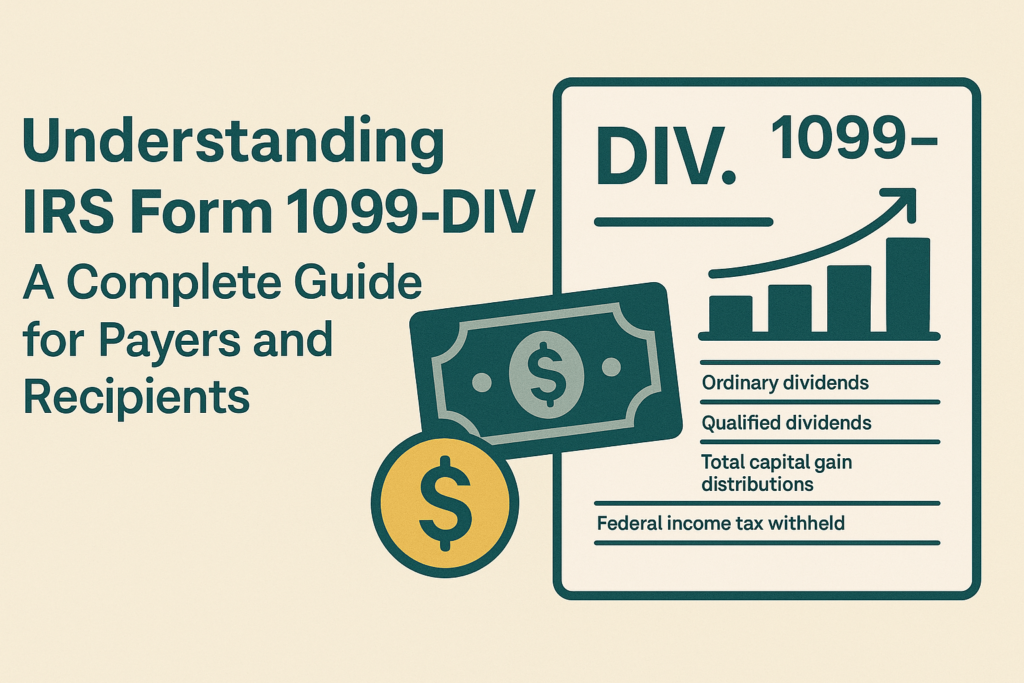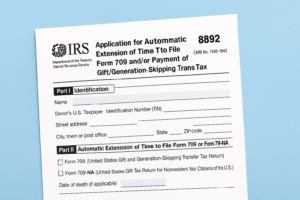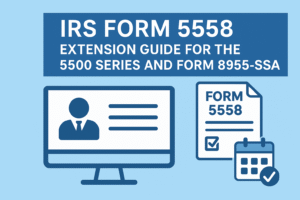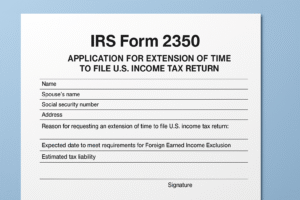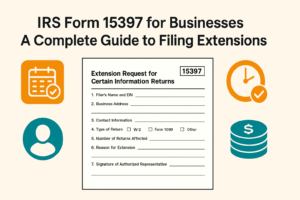Dividend reporting plays a crucial role in the U.S. tax system, ensuring investors are properly taxed on the income they earn from their investments. One of the key IRS forms used for this purpose is Form 1099-DIV, which reports dividends and other distributions to shareholders. Whether you’re a business distributing dividends, a financial institution, or a taxpayer receiving investment income, understanding how to handle this form is essential for accurate tax filing and compliance.
This comprehensive guide explains what Form 1099-DIV is, who must file it, how to complete it box-by-box, filing deadlines, and consequences for non-compliance.
What Is Form 1099-DIV?
Form 1099-DIV, Dividends and Distributions, is an IRS tax form used by corporations and financial institutions to report dividend income and other distributions paid to investors during the tax year. The IRS requires that any entity paying dividends totaling $10 or more to a recipient must issue this form.
This form helps ensure that recipients properly report taxable income on their tax returns and enables the IRS to verify that reporting.
Common types of distributions reported on Form 1099-DIV include:
- Ordinary dividends
- Qualified dividends
- Capital gain distributions
- Nondividend distributions
- Federal income tax withheld (if backup withholding applies)
What Is a Dividend?
A dividend is a payment made by a corporation to its shareholders, typically in the form of cash or additional stock, as a return on their investment. Dividends are commonly issued from a company’s earnings and profits and may come in different forms:
- Ordinary dividends: Most common type, taxed at regular income tax rates.
- Qualified dividends: Meet specific IRS criteria and are taxed at reduced capital gains rates.
- Capital gain distributions: Typically paid by mutual funds and regulated investment companies (RICs) from profits earned on asset sales.
- Nondividend distributions: Return of capital, not considered taxable income unless it exceeds the shareholder’s basis.
Who Must File Form 1099-DIV?
The obligation to file Form 1099-DIV rests with any entity that pays dividends or similar distributions to shareholders. This includes:
- Corporations (excluding S corporations, in most cases)
- Mutual funds and ETFs
- Brokerages and financial institutions
- Regulated investment companies (RICs)
- Real estate investment trusts (REITs)
- Banks or custodians of investment accounts
If dividends or other reportable distributions of $10 or more are paid during the tax year, the payer must furnish Form 1099-DIV to the recipient and file it with the IRS. Also, if any amount of federal income tax is withheld (e.g., due to backup withholding), the form must be filed, regardless of the total amount paid.
When Is the Deadline to File Form 1099-DIV?
The IRS imposes strict deadlines for filing Form 1099-DIV. Failing to meet them can lead to penalties. The key dates are:
- January 31: Deadline to furnish recipient copies of Form 1099-DIV.
- February 28: Deadline to file paper Forms 1099-DIV with the IRS.
- March 31: Deadline to file electronically with the IRS.
Note: If any of these dates fall on a weekend or federal holiday, the deadline shifts to the next business day.
Information Required to File Form 1099-DIV
Before completing Form 1099-DIV, you need to gather the following information:
- Payer’s name, address, and TIN (Taxpayer Identification Number)
- Recipient’s name, address, and TIN
- Account number (if applicable)
- Amount of ordinary and qualified dividends
- Capital gains distributions
- Nondividend distributions
- Federal income tax withheld, if any
- Foreign tax paid, if any
- CUSIP number and state information (for state reporting, if applicable)
Accurate and complete information ensures error-free submissions and minimizes the risk of IRS penalties.
How to Complete Form 1099-DIV
Each box on Form 1099-DIV serves a specific purpose. Here’s a breakdown of what to enter in each:
Box 1a – Total Ordinary Dividends
Enter the total amount of ordinary dividends paid, including any qualified dividends. This is the amount taxable at ordinary income tax rates.
Box 1b – Qualified Dividends
A portion of Box 1a. Enter the amount of dividends that are qualified for lower capital gains tax rates. Must meet IRS holding period and issuer criteria.
Box 2a – Total Capital Gain Distributions
Reports long-term capital gain distributions. These often originate from mutual funds or RICs and are taxed at long-term capital gains rates.
Box 2b – Unrecaptured Section 1250 Gain
Includes gains on the sale of depreciated real estate. Report this amount separately as it’s taxed at a maximum rate of 25%.
Box 2c – Section 1202 Gain
Used for gains on qualified small business stock held for over five years. Often eligible for 50% to 100% exclusion under IRC §1202.
Box 2d – Collectibles (28%) Gain
If capital gain distributions include sales of collectibles (e.g., art, coins), this amount is taxed at a maximum 28% rate.
Box 3 – Nondividend Distributions
Amounts that return capital to the shareholder. Not immediately taxable, but reduce the shareholder’s basis in the investment.
Box 4 – Federal Income Tax Withheld
Reports backup withholding—generally 24% of payments withheld when the recipient failed to provide a correct TIN or is subject to IRS enforcement.
Box 5 – Investment Expenses
No longer applicable after the 2017 Tax Cuts and Jobs Act, but still included on the form. Leave blank unless IRS reactivates its use.
Box 6 – Foreign Tax Paid
If any foreign income tax was withheld, report the amount here. This may entitle the taxpayer to a foreign tax credit.
Box 7 – Foreign Country or U.S. Possession
Identifies the foreign jurisdiction associated with Box 6.
Box 8 – Cash Liquidation Distributions
Cash distributions related to a partial or complete liquidation of the company.
Box 9 – Noncash Liquidation Distributions
Reports the fair market value of noncash assets distributed as part of a liquidation.
Box 10 – Exempt-Interest Dividends
Includes dividends from municipal bond funds or other exempt-interest sources. These are generally tax-exempt federally, but may be taxable at the state level.
Box 11 – Specified Private Activity Bond Interest Dividends
Tax-exempt dividends from private activity bonds. Must be reported for alternative minimum tax (AMT) purposes.
Boxes 12–14 – FATCA Filing Requirement and State Information
Used for FATCA reporting and to comply with state filing obligations. Include state name, ID number, and amount if applicable.
How to File Form 1099-DIV
You can file Form 1099-DIV with the IRS in two primary ways:
1. Paper Filing
- Submit Copy A of the form along with Form 1096 (transmittal summary).
- Mail to the appropriate IRS address listed in Form 1096 instructions.
- Only available for filers submitting fewer than 10 returns (as of recent updates).
2. Electronic Filing
- Use the FIRE system (Filing Information Returns Electronically) provided by the IRS.
- Mandatory for filers submitting 10 or more forms.
Additionally, provide Copy B to the recipient and Copy C for your records.
What Happens If You Miss Filing Form 1099-DIV?
Failing to file or furnishing incorrect or late forms can lead to IRS penalties. Penalties vary based on how late the form is and the size of the business:
- $60 per form if filed within 30 days of the deadline.
- $120 per form if filed after 30 days but before August 1.
- $310 per form if filed after August 1 or not filed at all.
- $630 per form for intentional disregard.
Penalties apply separately for both recipient and IRS copies, meaning errors can compound quickly.
Extension to File Form 1099-DIV
If you need additional time to file, submit Form 8809 (Application for Extension of Time to File Information Returns). This grants an automatic 30-day extension for filing with the IRS.
Important: This extension applies only to the IRS filing, not the recipient copy. If you need more time to furnish the recipient copy, consider submitting Form 15397, which can grant an extension for providing recipient statements.
Final Thoughts
Form 1099-DIV is more than just a reporting form—it’s a critical tool for maintaining tax compliance for corporations, financial institutions, and investors alike. Ensuring that dividend income is accurately reported, properly categorized, and filed on time helps avoid costly penalties and maintains trust in financial reporting.
If you’re responsible for issuing or receiving a 1099-DIV, staying informed about form instructions, annual updates, and filing requirements is essential. And with draft form updates released annually, it’s worth checking for changes that may impact your current tax year filings.

